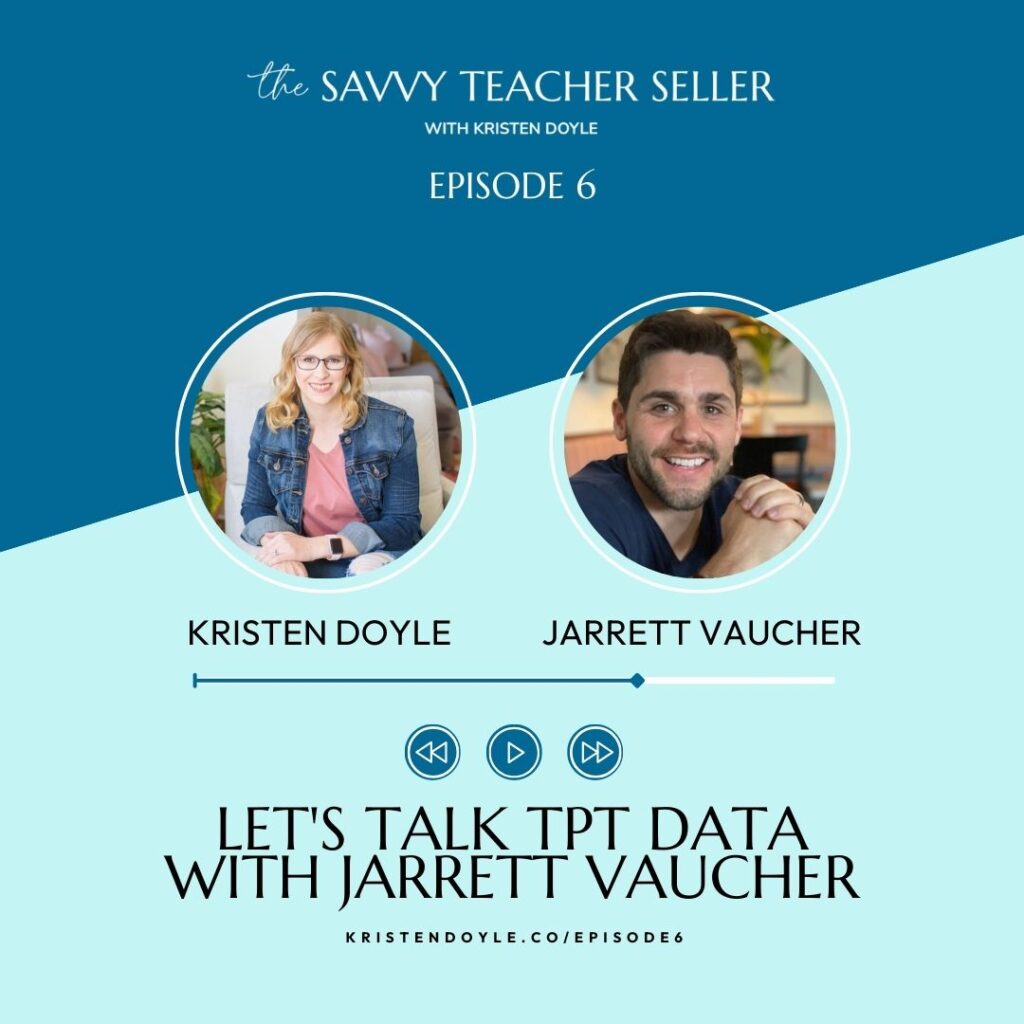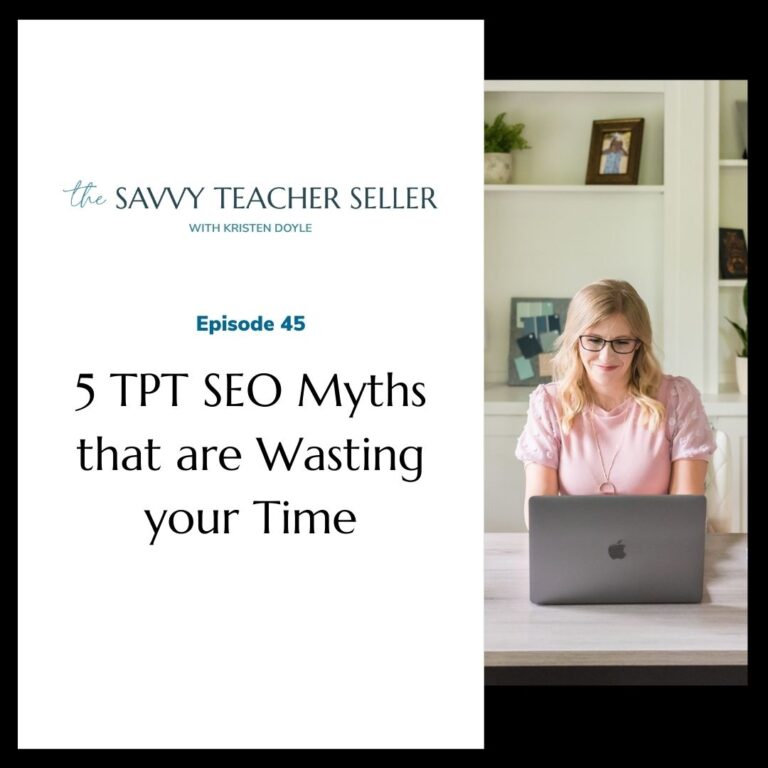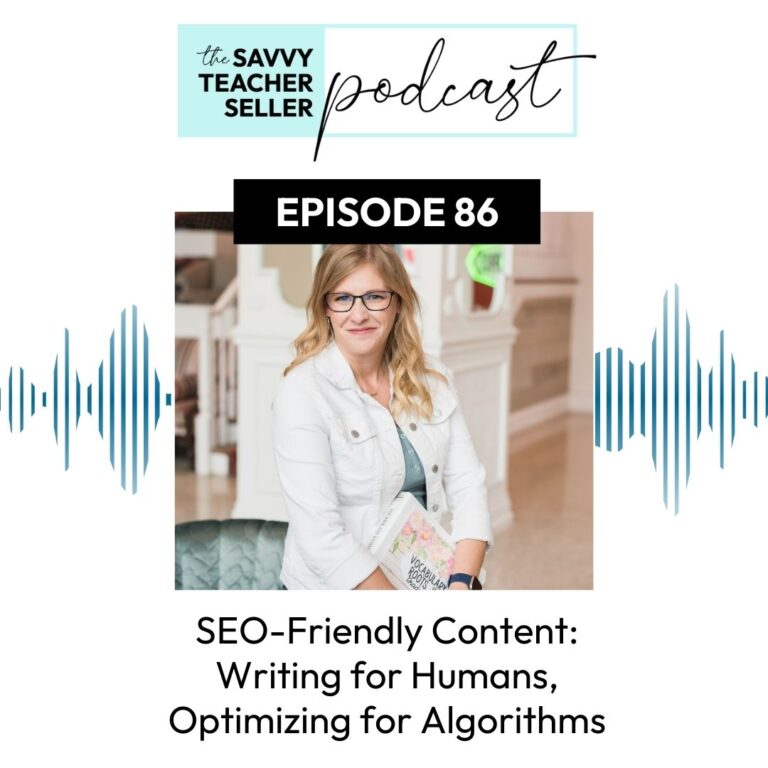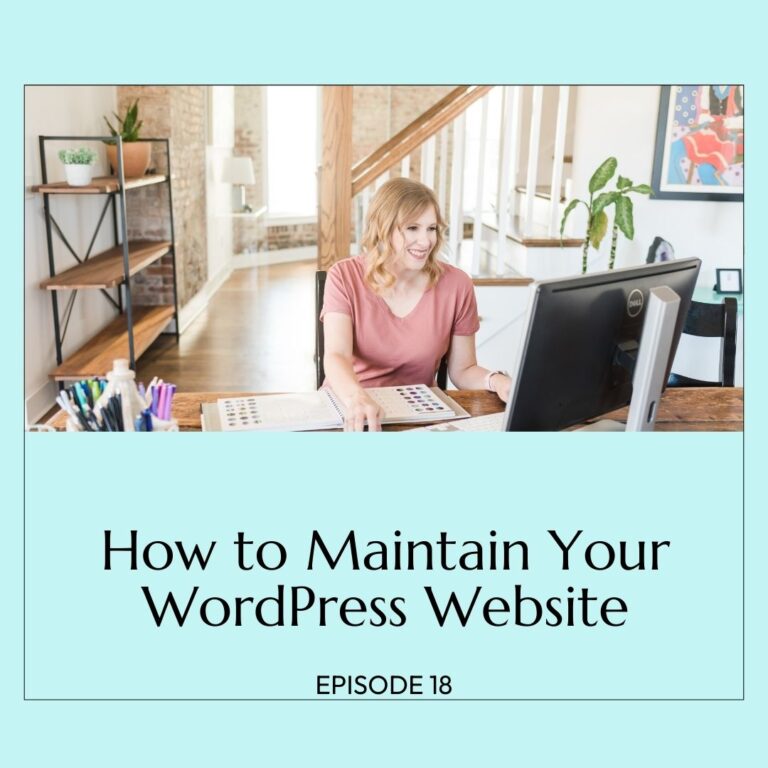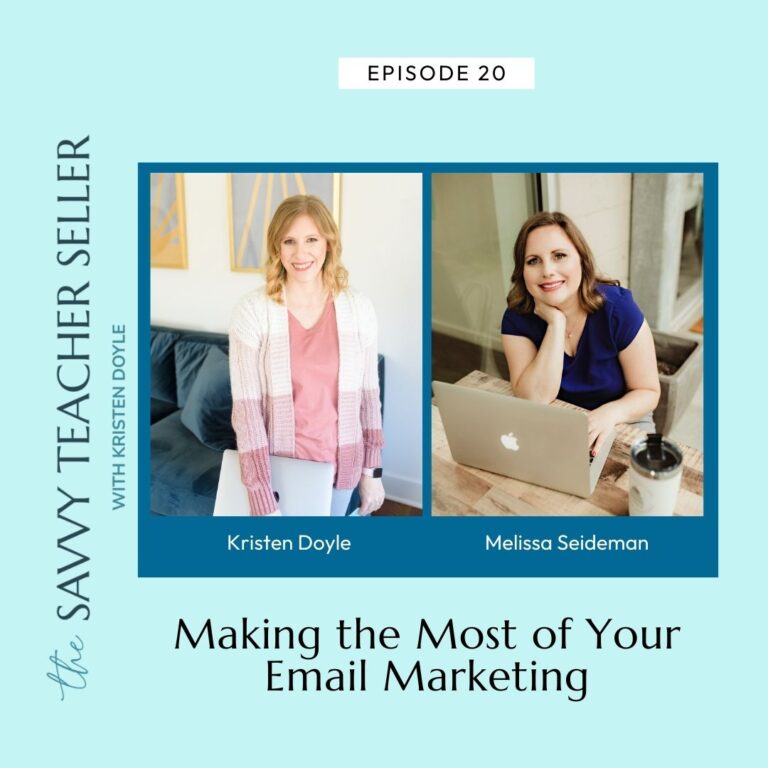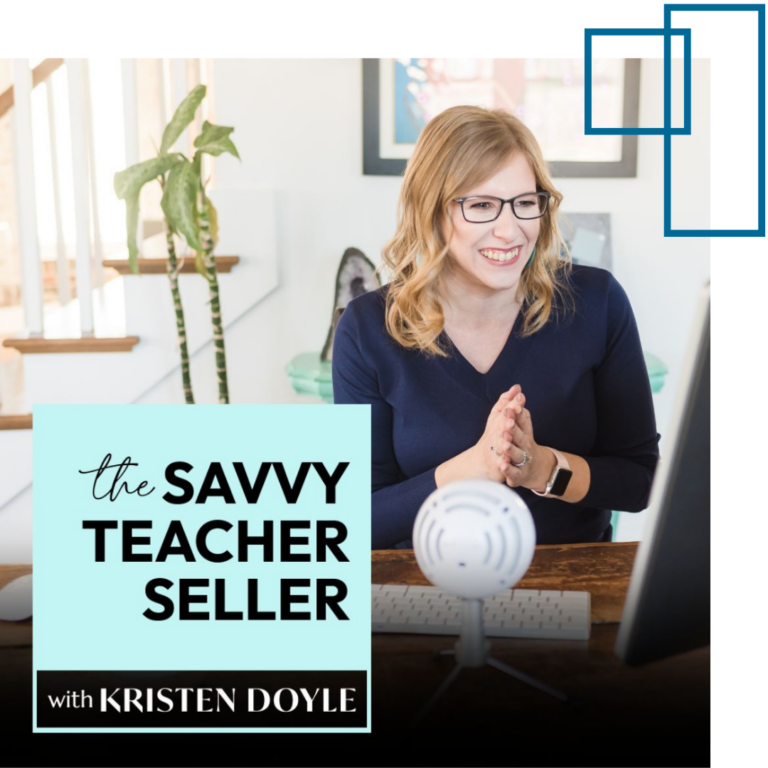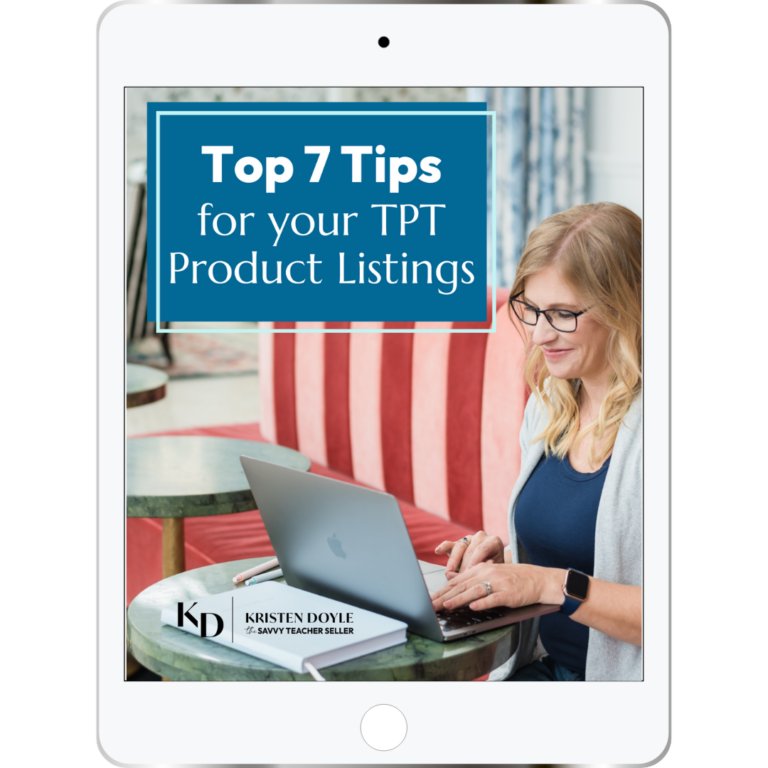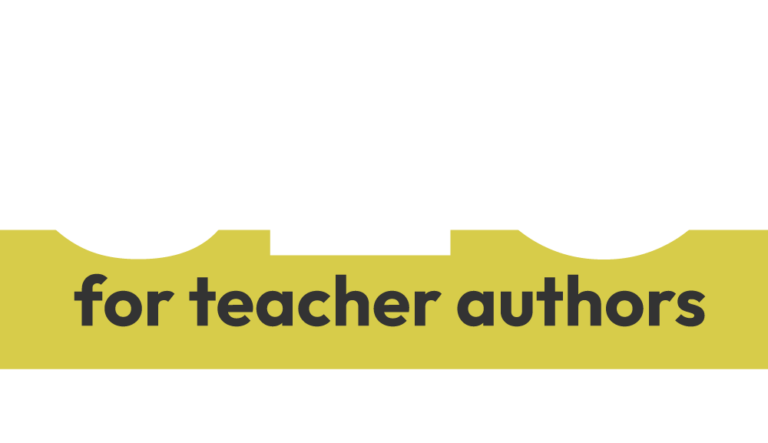Kristen Doyle:
Hey y’all thanks for joining me today for my very first guest episode! I’m so excited to have Jarrett Vaucher here today. Jarrett is the co-founder and Ceo of Your Data Playbook, alongside his wife Beth. She is the tpt seller and he’s the business guy that loves using data as your strategic asset to drive your strategy and your results for growing your tpt store.
Today we are talking about why data is so important for growing our tpt businesses, the most important data points, and what we should actually be doing with them, and we’ll cover where to start if you’re just starting to look at your data for the first time. Alright, let’s get on to the show.
Kristen Doyle:
Welcome Jarrett to the podcast today. Thank you so much for being here and talking with us about our tpt data. Tell us a little bit more about what you do for tpt sellers.
Jarrett Vaucher:
Hi hi Kristen! Great to be here. So am I officially the first guest? Wow, I feel so honored. So especially as data lovers right? We can unite around data and talk data. So this is super super fun. I’ve been looking forward to this since we talked about it.
So what we do really for tpt sellers. So first I’m Jared if you don’t know -I’m a data data lover, a business guy. I started using tpt data back in 2016 when my wife Beth started her store Inspiring Young Learners, and so again I’ve always been into data and wanting to use data to drive business results. So that’s how I got into it.
I was just seeing her data and looking at that and wanting to optimize her earnings for her store. So through her journey I helped her and so as a result of that, what we’ve done is created an analytics toolkit. We put it into a membership called Your Data Playbook.
So we really combined 3 things: automation, visual analytics, and coaching enablement to help eliminate barriers for teacher sellers like you. And to become data-driven because we believe it’s essential to be data- driven to thrive in the digital world and so we believe that data is the oil of the 21st century. But it’s very hard to work with right?
So it’s not easy and a lot of people have never used data. So our goal and our mission is to help lower those hurdles and we’re doing that in the membership that we created, Your Data Playbook. That’s what we’re about and again super excited to be here to talk data, talk shop.
Kristen Doyle:
Yeah, and you guys are doing such an amazing job at, like you said, lowering that hurdle and making it easier for us to use our data to look at those numbers and make data-driven decisions based on what we’re seeing to grow our stores. I know it is one of the best investments I have made for my business for sure.
Even though I understand the data pretty well myself, It’s so helpful to have someone else take care of gathering all the data and then putting it in a quick easy for me to look at format so that I can make those decisions really quickly.
What is it about data that you like so much for our tpt businesses?
Jarrett Vaucher
Good question. I like data in general. So my background, I ran an analytics team at a leading latin american airline. So I had a 10 person team and all our job was taking data and putting it into a data warehouse and then transforming it to get output to make sure that airplanes didn’t leave empty right? We were in charge of you know helping fill up airplanes with people’s butts and seats right?
Because once an airplane takes off, you can’t recover that lost revenue. It’s a very highly perishable good and service. So I fell in love with data in that industry and because seeing how you can drive results. So I’ve always been very action- oriented, very results oriented, since I was young.
My parents literally almost had me in the car on the way to the Hospital. My mom jokes like literally you came out superfast and you haven’t stopped running ever since.
And so I’ve always been oriented towards results and action, and so with data specifically in a service business or e-commerce like that is the fuel right? Without data you don’t have visibility of what’s working, what’s not working to drive your business results.
So It’s really about the action and what you can see if what you’re doing is actually making an impact or not. I like the data for the fact that I can actually influence change and see if that change is working or not to grow and meet that result. So that’s ultimately what’s my motivation behind and why I fell in love with it.
Kristen Doyle:
Yeah, it’s all about working smarter and not harder for me. If I’m making changes, if I’m gonna put in time on my resources, I want to know that I’m getting a result out of it and I want to know I’m making the right changes especially when it comes to things like pricing and is my preview converting well.
It’s so good to have numbers to back up the changes that we’re making so we’re not just going on gut feelings about things.
Jarrett Vaucher:
Exactly. I think that the keyword is visibility right? I think what it allows us to see what’s working and what’s not working because I know so many of you are time-strapped right?
There’s so many different things pulling you in so many different directions. So what we really want is to help you get the best return on your investment to be able to know where to focus and which lever to push for your growth, and you use data to identify that and then do that and then evaluate the results. So we’re deeply motivated by helping you make an impact on your business and seeing that result.
Kristen Doyle:
Yeah, that’s awesome and we are. Tpt sellers in general, we are so busy. Some of us are still in the classroom. Some of us are running multiple businesses. Some of us are, lots of us have our own families that we’re trying to be present with as well. So we really do have all of the plates in the air it seems like, at the same time.
And this is something that really does help us to focus in on the things that are worth our time. The things that are going to move the needle for our businesses.
Jarrett Vaucher:
It’s crazy. I’m so impressed by teacherpreneurs. It’s like, my mind’s blown. Like how are you doing this this, this, and this? It’s crazy. If we can make your life a little bit better and and provide value and so this is how we figured we could do that for this community.
Kristen Doyle:
Absolutely. Well speaking of having too many plates in the air and finding the right things to do, what are the top data points you think are most important for tpt sellers to look at when it comes to growing our store?
Jarrett Vaucher:
I mean it’s really 3 things. It comes down to traffic, conversion rate, and price. Those are the big 3 growth levers for your store. And again, if you’re just to focus on one, and you totally agree with it, because this is where your business aligns tremendously Kristen, is it’s traffic right?
You need traffic. Everything starts with traffic. It doesn’t matter if you have the prettiest cover and the most persuasive preview. If no one’s actually seeing your product, it’s end of game. Like it all starts there. So I would say the most important thing is just you got to have the traffic first if you want to do anything.
Kristen Doyle:
Yeah, absolutely agree, and so on tpt that would be our page views. And then so the next step then if we’re looking at our page views, our conversion rate, and our price, how do we know what actions to take based on that data that we have?
Jarrett Vaucher:
Oh that’s a good question. Really, it’s relative to that particular performance. So if you have decreased page views, understanding why you have decreased page views.
So is that because your search rank has fallen? Is that because there’s new competitors in the market? Understanding why those pages have fallen and then figuring out how you can recover those specifically.
If you’re just focusing on tpt that would be going in and doing some seo optimization like keyword research and then figuring out how to make your title and snippet and description more robust so that you show up and that might mean actually swapping out a less competitive keyword and actually using one where you’re going to rank higher. I think you would agree with that.
So that you actually get more visibility. So you’re not on page 17. Instead you’re on page one. It’s a less competitive term with less volume meaning less traffic or page views. But you’re going to get seen right? That’s the key there with traffic is visibility.
Kristen Doyle:
That’s something I was actually talking with some of my clients about earlier today is choosing the less competitive keyword when your product is newer or it doesn’t have much traction built up. It’s not selling as much yet. And then shifting over to more competitive keywords once it gets some momentum.
Jarrett Vaucher:
Yeah I think that’s the name of the game is just figuring out when to make that transition because I think some a lot of people think about. Okay I’m going to go for that like the heavy hitter, the most competitive, but then reality you end up on page 19 when you launch a new product and it’s super discouraging.
So like being realistic in the lining that, say hey, you know what I’m going to manage this differently and and so having a launch strategy I think is key. Having a launch strategy for your new products and actually saying hey I already have done my keyword research and knowing, give an estimate of where you think that new product can land in terms of search and what specific terms that you’re actually showing up for right away.
So if you launch a new product and you’re on 17 you’re not going to get traffic and so it’s gonna be super dependent on what? You generating that traffic right? You’re gonna have to send emails, you’re gonna have to do Facebook ads, you’re gonna have to do Instagram.
That’s super super valuable. Focus on, and actually downshift to a less competitive keyword at the start and then you can upgrade later on once it has traction.
Kristen Doyle:
Right. Once it starts gaining a little traction and you can compete with some of the higher traffic keywords.
Jarrett Vaucher:
Yep, and then from a conversion standpoint, there’s just three… I mean how much time do we have? You know we could talk about this all day. B ut yeah I think the biggest thing here in and terms of conversion I mean one of the hottest topics that we talk about and everyone in tpt talks about are previews
Previews are so impactful. If you have an underperforming conversion rate, one thing to look at is hey your preview. Your preview definitely makes a big impact on your conversion rate and I’ve said it multiple times, but tpt states that 62% of buyers have stated in their research that it makes the biggest impact on a conversion decision or not after price.How robust that preview is. Is it is it compelling? Is it showcasing the product?
Because the preview is essentially like the digital equivalent of like going to a house when you’re going to buy it and doing a showing of a house. You aren’t going to just buy a house site unseen.
You’re going to go on a tour. Make sure that hey the doors close. It said on the listing that it has 3 rooms and it actually has 3 rooms. You can’t do that in the digital world right? You can’t.
So how do you do that? The preview is the equivalent of like going to view a house or like the equivalent of a test drive on a car. Preview has so much weight and it creates that confidence when purchasing. And we we did a study.
With Your Data Playbook, we have access to like 160,000 products with the active members that we have, and so 26% of them actually didn’t have a preview right? So we looked at those products with a preview and those products without a preview and we found that the products with a preview converted like 13.2% better.
Kristen Doyle:
And that’s just a preview right? Just having 1?
Jarrett Vaucher
Exactly. Just like crazy right? Literally the preview could be 1 page. That’s all we evaluated is hey does does a preview exist, yes, or no?
Kristen Doyle:
And when you looked at that, you are looking specifically at a PDF preview right?
Jarrett Vaucher:
Right. Now video previews, we have limited visibility. I think video previews in the right context can convert even better. But we’re just looking at Pdf Pdf previews.
I think if you have a really poor converter, then that’s a great thing to evaluate, is looking at your preview. If you take that 13% better, if you actually put that in context, essentially let’s say you have a product that converts at 4% and it doesn’t have a preview, if you add a preview it bumps it up to 4.5% just by adding a preview.
And let’s say that product has like 2,000 page views in a month and essentially what that equates to just by adding that preview getting an extra half of percentage point on a 2000 page view product a month, plus let’s say $15 is the average price, that equates to like $2,300 extra for the whole year. So that’s what the data shows us.
But do you like making previews? I know so many teacherpreneurs don’t. It’s a pain right? It’s a thorn in your side. That’s the last thing I want to do.
Kristen Doyle:
I don’t, but I will say I like making previews a lot better now that I know how much they help my conversion rate. It’s a lot easier to want to do them when you see the data and you see that it really does improve.
So I guess if people are looking at a low conversion rate, the first thing then you would suggest is if it doesn’t have a preview, add one. And if it has a preview, then what? Look to see if you need to improve it?
Jarrett Vaucher:
Absolutely. Yeah, and optimize it. See if you can structure it. Again, iis it actually telling people what the product has and then is it actually showcasing the product well? Like the sequence of information there is is key to help build that confidence.
So yeah, how you can make product preview more robust so it’s more compelling and persuasive to convince in the purchase decision.
And then price, it’s really about, hey if you have a top converter or a bottom converter. That’s the next thing I would look at. You could be leaving money on the table, so optimizing for pricing. That could be just small increments, 5% in price changes to see how the market responds.
That’s one of the common myths that I hear. I get it. It’s an FAQ that I feel a lot is like, well I’ve heard that you’re only supposed to increase prices and never decrease them. But I don’t know, in any other industry, that’s not the case. So I don’t know why that’s like this prevailing thought in this community. And some people like I don’t agree so but in any other industry you lower prices and you raise prices. That’s just business.
Kristen Doyle:
Yeah, exactly and I think a lot of Tpt sellers, at least from what people have told me, they’re worried that if they lower their price then someone who bought it when it was more expensive is going to be upset that it’s a lower price now.
My standpoint on that has always been, we are so much more focused on the pricing in our own stores than our customers are. They aren’t coming back to check and see if we put something on sale or not for the most part. And I know we’ve all gotten a Q&A here and there where someone says I didn’t know there was going to be a sale. Can I get the discount?
Jarrett Vaucher:
Teah, absolutely yeah.
Kristen Doyle:
But for the most part teachers aren’t coming back to check and see if you’ve changed your prices. So I always tell my clients pricing is not permanent. Change your price. It’s okay.
Jarrett Vaucher:
Yeah, exactly. There’s A/B decisions right? A, you can walk through the door right? and it closes behind you. You can’t walk back through it.
B decisions, it’s like a revolving door in the front of a hotel. You can go in and out multiple times. Like pricing is not permanent and that’s what we love about data right, is you can actually see how the market responds.
It gives you visibility to how the market responds. Did your conversion go up? Did it go down and then you can adjust accordingly. Yeah, so I think that’s the biggest thing and that can be the quickest bang for your buck If you have super limited time is just changing a quick price and seeing how the market responds.
We did a survey to see okay because that that was one of those, like let’s validate this assumption. Let’s validate this thought. And it was like over a 100 people responded in the membership and I think 2 people actually said that they had someone complain after changing a price.
So it can happen but that’s 2% and so it’s very limited. I mean imagine going to your local grocery store or like going shopping at the mall like retailers have sales all the time. Right? When was the last time you went and you bought a pair of shoes or you bought a dress or something and for full price and then you came back a month later and it was half off.
Kristen Doyle:
Yeah, and I might be mad at myself that I didn’t wait for the sale or wasn’t paying attention when it was on sale last week and forgot but I’m not mad at the store because they changed their prices. I just know that’s how it works.
Jarrett Vaucher:
Yeah, exactly. It’s fun to talk about price. I think that’s one of the least talked about and most underutilized growth le vers that can really have a big impact.
Kristen Doyle:
I love playing with my prices because it’s easy. You take a look at it. You make a change in 20 seconds and you watch your data for a little while and see what happens and make a change back if you need to. I tend to push push push push push until I feel like I went too far.
Because I think as TPT sellers, we tend to underprice most of the time.
Jarrett Vaucher:
I was just going to say the same thing.
I think that’s what I’ve seen too Kristen, is like coming into this this marketplace in this community, I think the default is under price. And again you want to be sensitive to teachers I understand that but there’s there are the legitimate products that have a great value that are converting at twenty thirty percent and you’re way underpricing that product and it’s worth a lot more.
You know, price for value and you can test that with pricing changes and so you can say the market actually bares and thinks it’s this valuable. Okay I’m going to leave it here and I see that response in the market. The market will tell you if they think it’s too expensive. You have that.
Kristen Doyle:
Right. Absolutely, and you can play with pricing. You can test out pricing changes and still be sensitive to teacher budgets and not overdo it and like you said if you overdo it, the market’s going to tell you.
So you said pricing was kind of a misnomer that we can’t change prices down. What are some other misnomers around data that you’ve noticed?
Jarrett Vaucher:
The the whole thing about like how long do I have to wait before I see ou a change? Like when I make a change to data. That’s something we often get in the membership was like hey, is it time bound? How much time?
I mean I think you and I would agree on this too right? Like it’s not time bound. It’s really a function or it depends upon how many page views right? What are page views for us in this environment? They’re demand, so you evaluate your changes.
But basically what we want to evaluate is, how did the market respond? What’s the best indicator of that is first we need to look at page views and we look at page views in terms of collecting our data or collecting our sample size.
And we get page views. We need 300 page views about to start being able to see if hey it’s not just by chance that what I did impacted – negatively or positively.
That’s one of the biggest things that we’ve had to change besides price in terms of, how we think about those changes and it’s not time bound. It’s page view bound.
Kristen Doyle:
Yeah, it’s not an amount of time after your change so much as how long does it take you to get 300-400 page views because that’s a good amount of data and for anybody wondering where that number comes from, we need a certain amount of data in order for something to be considered statistically relevant.
I’ve always said 400 and I know you always say 300. You’re probably more accurate than me.
Jarrett Vaucher:
With 300, you need to see a big change. Um, well actually I’m gonna pull back. But yes, 300 is a good starting plot but the more data that you can gather, the smaller changes that you make, you’ll actually be able to see that response even better.
So if there’s not a big change, collecting more data will actually see hey did that make a positive or negative impact. So did that make sense?
Kristen Doyle:
Yeah, absolutely absolutely. So we have some questions that some people in my audience have submitted so can we do some kind of rapid fire quick answer questions before we finish up today. All right here we go.
Jarrett Vaucher
Let’s do that.
Kristen Doyle:
For sellers that are new to looking at their data, what do you think is the first thing they should look at?
Jarrett Vaucher:
Page views.
Kristen Doyle:
And then work on Seo of course if they’re not getting as many views as they want.
Jarrett Vaucher:
Yes, hands down. For new sellers I think, well you said rapid fire, so page views on TPT, seo, what’s what I would say right there.
Kristen Doyle:
And we had a kind of related question. What are small actions that low traffic sellers can take to begin their journey to being data driven on the right foot? So if they look at their page views and it’s low, what are the first things you would suggest they do?
Jarrett Vaucher:
We’ve touched on it a little bit. It’s essentially you know, understand where those products ranking right? If they’re ranking super low in those current products in the keywords that they’re tagging. How do you shift swap those out to less competitive keywords so that you can get higher up in rankings to drive more page views.
And then I think for, if let’s say you can’t and you’re stuck, and like hey this is optimized. It’s the best keyword that you can use, then you’re going to want to look at, how do you make that product convert better?
So like what we’ve already talked about. Previews. But we’ve talked about price. So then you can go to those different growth levers but start with page views and optimizing those and then work your way through conversion and and price.
But I think the biggest bang for your buck would be page views and optimization through Seo on tpt, especially if you don’t have money to invest in an email list. I think that’s the biggest thing.
Kristen Doyle:
Yeah, absolutely, I completely agree. Here’s an interesting one. How important do you think UTM codes are?
Jarrett Vaucher:
I think I think they’re highly important when they’re accurate right? So because it allows you to understand where your traffic is coming from and if your marketing initiatives are having an impact driving to the result. So I think they’re super important because it’s another way to track and see if what you’re doing is making an impact.
I think when accurate they’re important. Again, we know sometimes the data for that on tpt is less than accurate so that can make our credibility, our belief in that data, less valuable but the concept itself is valuable.
Kristen Doyle:
Okay, last kind of rapid fire question for you. What are the most surprising things you have learned since you started YDP? Maybe some trends you’ve noticed about the cohort data overall or something that you didn’t think would be as important as it is. What has surprised you?
Jarrett Vaucher:
I think the common misnomer that more products always equals more growth. Actually seeing that and seeing people that have had you know six figure years half a million dollar years and they have completely different, like 1 store has 500 products and 1 store has 200 products right?
So I think because I think there’s also this thing in like oh the more products you have the more growth you have or like the more followers you have or the more reviews you have like there’s a kind of vanity matrix to a certain extent, meaning like they don’t necessarily drive or correlate to direct growth.
I think that number of products equals a bigger seller, which in some cases it doesn’t.
Kristen Doyle:
Yeah, that’s true, very true and you’ve shared a statistic with me 1 time before. I don’t know if you remember it off the top of your head but a statistic about how much our store could grow purely by adding new products versus by optimizing what we have based on our data.
Jarrett Vaucher:
Oh yeah, so in the summer study we looked again and the 160,000 products that we have available in YDP. We looked at how much, so new products that were created, how much they contributed to the overall stores page view growth and growth in that year. So the same year that they’re created.
It was 9%. Let’s say you want to grow 20% what we found is just by creating new products, you’re only actually, again on average. There’s exceptions to the rule. Always.
But on average you’re going to grow 9% by creating new products. So if you have a goal of 20% from growth. You’re going to have to do other things like we talked about like those other growth levers. You got to push on those, like traffic conversion and price.
Kristen Doyle:
Right? And really letting older products sit in your store and not pushing on any of those growth le vers. It’s just kind of leaving money in the bank I guess money in someone else’s pocket. It’s just missing out on sales that you could be having without doing a lot of work.
Jarrett Vaucher:
Yep, yep. But again, I’m not anti-creation right? Beth loves creation and but I just want you guys to get all the juice out of the resources that you have and make them work harder for you, and so if you have something that’s sitting on the shelf, get get get that puppy optimized get it going get in front of people so that you make more you make more money for your store and then you can you know reinvest in a VA or someone who can do other tasks that you don’t like to do.
You can get back to creating if that is your jam and that’s what gets you up in the morning like so we’re totally for that. But doing it smartly, intelligently, and intentionally.
Kristen Doyle:
Yeah, intentional really I think is the key when it comes to our data. It helps us be intentional about the things we’re working on in our business whether we’re spending time right now on optimizing previews and thumbnails or we’re spending our time on Seo or maybe it’s time to be creating new products because we’ve got that stuff on lock already.
And it’s now we’re ready to focus on being creative and making new things again.
Jarrett Vaucher:
Yeah absolutely. I mean Beth, I love the energy that I see when she creates a new product. You get to see it in her eyes and she lights up.So you don’t want to defuse that.
But it’s like hey babe, if you want to keep creating we got to do these other things so you can spend more time creating.
But one of my favorite things I’ve seen Kristen too is like just helping reorient the sequence. So sequence equals success right? So like oftentimes in strategy it’s about not what you’re doing.
It’s often times what you’re not doing and what you’re doing right? You have to say no to more things than yes to more things right? So knowing which things to say no to so you can focus on the yes things.
And so sequence, knowing hey I just built these products. All right now I’m going to optimize them and so getting that sequence right is key.
Kristen Doyle:
Yeah, it really is. Well I always like to leave my listeners with an action step. So if our tpt seller friends take 1 action step after they listen to this episode, what would you recommend that it be?
Jarrett Vaucher:
So many things, so many things. Well I mean since you’re like the Seo Queen right? I would think for those products, specifically like the question about the the low sellers, or the sellers that are not getting a lot of page views, I think it’s there’s got to be markets where you can focus and optimize on seo for getting more traffic.
So I think that’s the start of everything, so where can you focus, where can you swap out some page views, or swap out some keywords to get you some more page views? That would be the biggest thing I was going to focus on.
Kristen Doyle:
Yeah I love that. Thank you so much for being here. This was super fun. I really appreciate it. I know we could talk forever about data.
Jarrett Vaucher:
It’s fun. I Love I Love what you’re doing and so supportive of what you’re doing and how you contribute back to the community and so thanks again for having me on here. It was fun.
Kristen Doyle:
You’re welcome. Thank you for being here. Tell everybody where they can learn more about you and your data playbook.
Jarrett Vaucher
Yeah, you can just go to yourdataplaybook.com and currently, it’s not open but we’ll probably open sometime early Fall.
So you can get on the waitlist, you can check it out, see if it’s a good fit for you, and if you have any questions you can email us at [email protected]. That’s us and again thanks so much for having us and we are delighted to be partnering with you.
Kristen Doyle:
Thank you so much for listening today. You can find all of Jarrett’s info and info about YDP in the show notes at kristendoyle.com/episode6 and be sure to share this episode with a tpt friend. Talk to you again soon.

